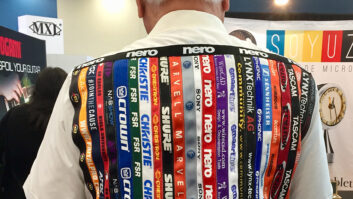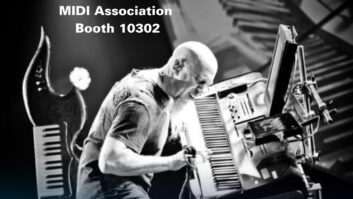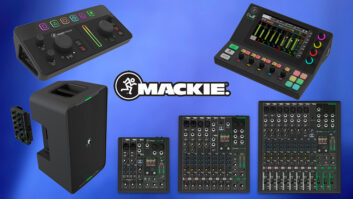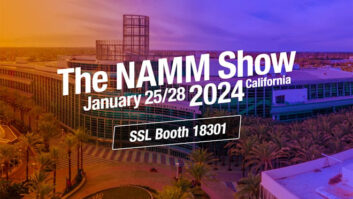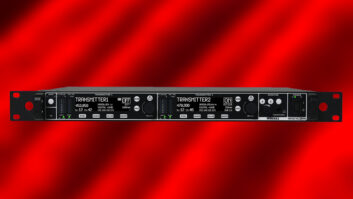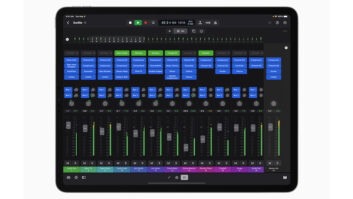Here’s the lead sentence for last year’s Winter NAMM show column: “In my April 2010 column written after the debut of Apple’s iPad, I wrote, ‘The age of desktop dominance is over, which has major implications for our industry.’” Well, it’s time to recycle that opener, because NAMM 2012 showed us those implications are spelled i-P-a-d.
WaveMachine Labs, the company behind Drumagog, introduced Auria—a $50 iPad app that’s the poster boy for the wave of the future. It offers 48 tracks of playback on an iPad 2 (24 tracks on the original iPad), a channel strip from PSP Audioware, various other plug-ins, major editing, and the ability to record up to 24 tracks simultaneously. Optional plug-ins are available, but Auria also runs VST plug-ins (up to four plug-ins per track) that have been ported to iOS format.
This is no toy: There’s 64-bit, double-precision architecture, path-delay compensation, subgrouping, dual aux sends, automation, customizable pan laws and even an included convolution reverb. Basically, it has the power of a top-of-the-line DAW from only a couple years ago; we already saw a doubling of CPU power when the iPad 2 replaced the original iPad, so we can only imagine what’s on tap for the iPad 3. With Auria, the question isn’t whether you can replace your desktop with a laptop, but whether an iPad is all you really need.
However, Auria was one of the few new standalone iPad applications because (also as predicted previously) it’s hard for a company to make any money at app store prices. Instead, the iPad’s primary role is integration with existing hardware products; for music industry companies, the iPad has become the equivalent of an OEM processor/display combination— provided by the end-user. NAMM was filled with products that would have cost hundreds of dollars more had the companies needed to provide their own processing power and display, while for buyers, amortizing the iPad’s cost over multiple devices increases cost-effectiveness dramatically.
Mackie’s DL1608 mixer was one of the hot iPad-based devices. The mixer hardware serves as an I/O dock for the iPad, which provides the GUI for mixing, EQ, and other mixer elements (and yes, you can remove the iPad from its “mixer dock” and do remote control). But Mackie wasn’t the only company with an iPad mixer. Alto Professional’s Masterlink Live mixer (available in 16- and 24-channel versions) takes a different tack as it can serve as a conventional hardware mixer, but also uses the iPad as an accessory to provide signal analysis, live recording, and “outboard” signal processor control.
The Alesis/Numark/Akai family of companies also adopted the iPad in a big way. The Alesis DM Dock is an electronic drum “brain” that combines the nowcommon configuration of a sturdy hardware dock with I/O, a place to insert the iPad and an app. With DM Dock, you can drag and drop drums from a browser into your onscreen, virtual drum kit and download new sounds— even in the middle of a performance (which brings new meaning to “more cowbell!”). Their Amp Dock for guitar runs any iPad amp sim, but also includes a footswitch/ pedal hardware box for control, so you can put the Amp Dock on a mic stand or table for easy editing, yet foot-control parameters. Numark’s iDJ Pro weaves the same iPad magic into DJing, while Akai’s MPC Fly wraps hardware around an iPad running MPC software.
Sure, there were plenty of products with built-in touch screens and processors, and given Apple’s penchant for making abrupt changes, that adds a certain amount of comfort with respect to future obsolescence, or does it? Proprietary parts for a fiveyear- old product might be hard to find, but five years from now, you’ll probably be able to pick up a refurbed iPad. Future iPads may even be backward-compatible to some degree. (When a DigiTech rep was asked if its iPB-10 processor would be compatible with the iPad 3, he answered that he had a very high degree of confidence regarding compatibility—the unit already ships with two different trays to accommodate either an iPad 1 or 2.)
The iOS world has also created a ripple effect of products like Apogee’s MiC, a microphone for iOS devices that interfaces digitally in order to bypass the—uh, “less than stellar”— analog preamps. MiC uses Apogee converters, but also features a front-mount clip LED so the singer can see if levels are too loud (a simple, but genius, feature). Interfaces now boast iOS as well as USB and/or FireWire compatibility; in fact, it was difficult to get through just about any presentation without hearing the words “iOS compatibility” mentioned in some context.
For pro audio and music, the iPad was the star of the show… and Apple didn’t even have a booth.
Craig Anderton is executive editor of Electronic Musician magazine, and editor-in-chief of harmonycentral. com

